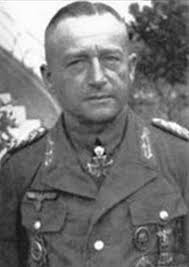
Wolfgang Fischer was born on December 11, 1888 in Carolath, Upper Silesia. He entered the service as a Fahnenjunker in the 154th (5th Lower Silesian) Infantry Regiment on March 18, 1910. A career infantry officer, he was transferred to the 7th Landwehr Infantry Regiment as a platoon leader when World War I broke out, but was soon promoted to company commander. He was named adjutant of the 3rd Landwehr Division in late 1915 and became adjutant of the 22nd Landwehr Infantry Brigade in the fall of 1917, serving on the Western Front. He emerged from the war as a captain.
During “the war after the war,” as the civil unrest of 1918–1920 was called, Fischer joined a battalion of volunteers. He was accepted into the Reichswehr in 1919 and was posted to the 3rd (Prussian) Infantry Regiment at Deutsch Eylau, East Prussia (now Ilawa, Poland), in 1920. He remained with the regiment until 1929, working as a regimental adjutant and as a company commander. In 1929, he assumed command of a company in the 6th Infantry Regiment at Luebeck and remained there until 1934. Promoted to major in 1932 and to lieutenant colonel in 1935, Fischer directed a battalion of the 46th Infantry Regiment at Neumuenster from 1934 to 1937, when he was promoted to colonel and joined the staff of the 69th Infantry Regiment at Hamburg. He assumed command of the 69th on February 4, 1938, during the Blomberg-Fritsch purge, when Hitler removed many anti-Nazi or non-Nazi officers and sent them into forced retirement.
Fischer’s new unit consisted mainly of former Landespolizei (provincial policemen). They made good soldiers and fought well in Poland in 1939. Then, on October 27, 1939, for reasons not made clear by the records, Fischer was given command of the 10th Rifle Brigade of the 10th Panzer Division, which was then in the process of forming. Fischer led it in France (where he earned the Knight’s Cross) and in the early stages of the Russian campaign, where he fought in the battles of encirclement of Minsk and Smolensk as part of Guderian’s 2nd Panzer Group.
Fischer was promoted to major general effective August 1, 1941. The next day, he assumed command of the division. (His former commander, Ferdinand Schaal, had been picked to command a corps in France.) Fischer distinguished himself as a divisional commander during the drive on Moscow, although his division suffered heavy casualties.
In the spring of 1942, the 10th Panzer was one of the divisions selected for a return to France, this time to rest, rebuild, and reequip. When the armies of Vichy France failed to offer more than token resistance to the Allied invasion of North Africa, however, Hitler ordered it occupied in November 1942. As the main German armored force available, 10th Panzer spearheaded one of the main columns, but experienced no resistance.
Meanwhile, the Allies drove on Tunis and threatened the rear of Rommel’s Panzer Army Afrika in Egypt and Libya. To meet this threat, Hitler created Headquarters, 5th Panzer Army, and rushed reinforcements to the endangered sector. The most significant of the reinforcements was the 10th Panzer Division. Fischer (a lieutenant general since November 1) directed and led a series of brilliant counterattacks against the Anglo-American spearheads and pushed them back, thus saving the Tunisian Bridgehead. Then, on February 1, 1943, during the Battle of the Mareth Line, Fischer’s command vehicle drove into a poorly marked Italian minefield. Wolfgang Fischer lost both of his legs and an arm in the ensuing exploration. He was fully conscious but in great pain and knew that he would soon bleed to death. With iron self-control, he ordered that some paper be brought to him, so he could write a farewell letter to his wife. He had written a page and a half when death overtook him. In recognition of his courage and undeniable skill as a panzer leader, he was posthumously promoted to general of panzer troops and was awarded the Oak Leaves to the Knight’s Cross.